Ulster University: BMG531 Effective Organizations TQM Analysis Report
VerifiedAdded on 2020/07/22
|8
|2106
|68
Report
AI Summary
This report delves into the principles and practices of Total Quality Management (TQM) within the context of an organization, WUR. The report begins with an introduction to TQM, emphasizing its importance in achieving organizational goals and objectives. It then outlines the process of TQM implementation, including clarifying vision, identifying critical success factors, developing metrics, and soliciting customer feedback. The report further examines the costs associated with TQM, differentiating between commodity needs, value designing, and assuring standards. It also analyzes the costs of failures, both internal and external. The report concludes by highlighting the different principles of TQM, such as client-centered focus, total worker inclusion, process focus, integrated systems, strategic approach, continuous improvement, truth-based decision making, and effective communication. The report provides a comprehensive overview of TQM, offering valuable insights into its implementation and benefits for organizational effectiveness and performance.
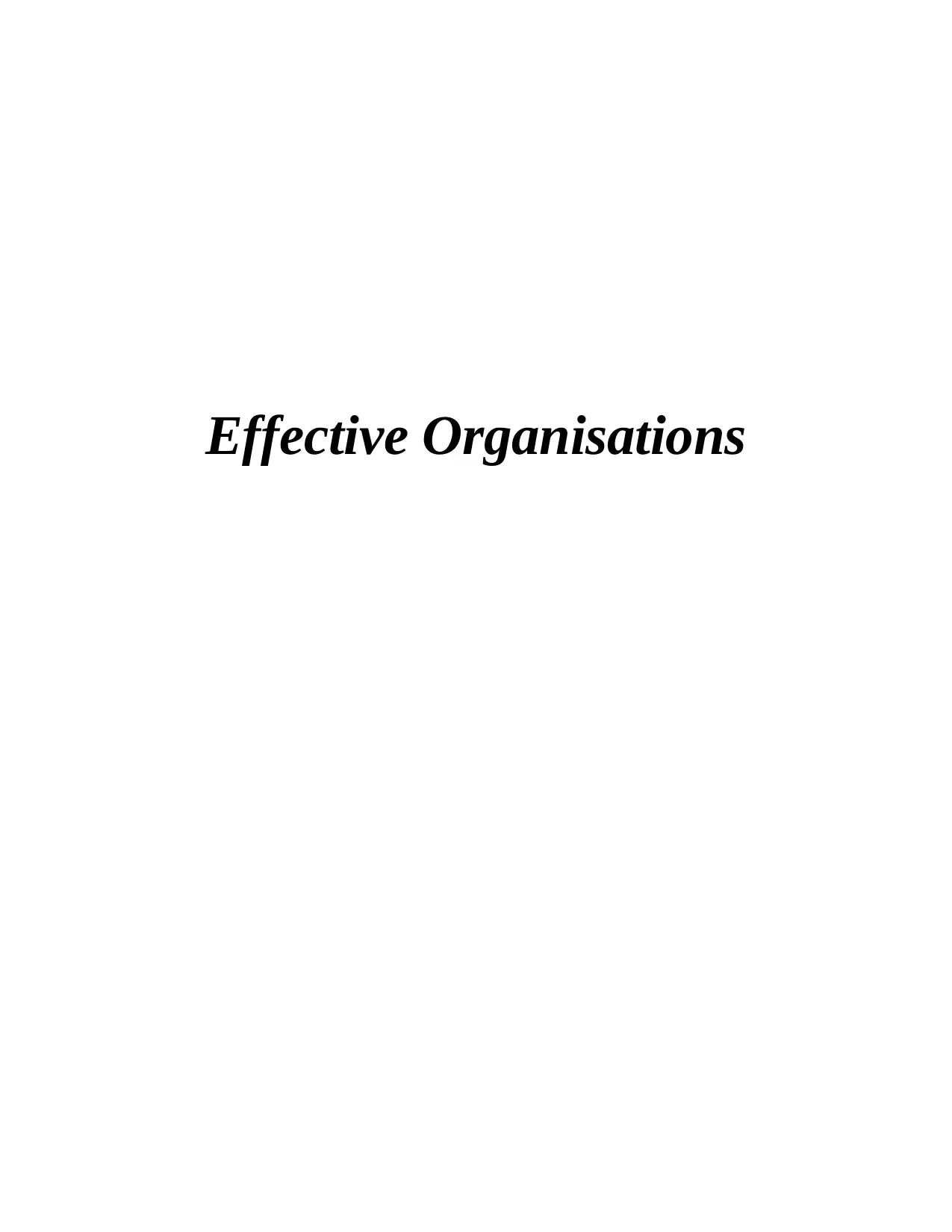
Effective Organisations
Paraphrase This Document
Need a fresh take? Get an instant paraphrase of this document with our AI Paraphraser
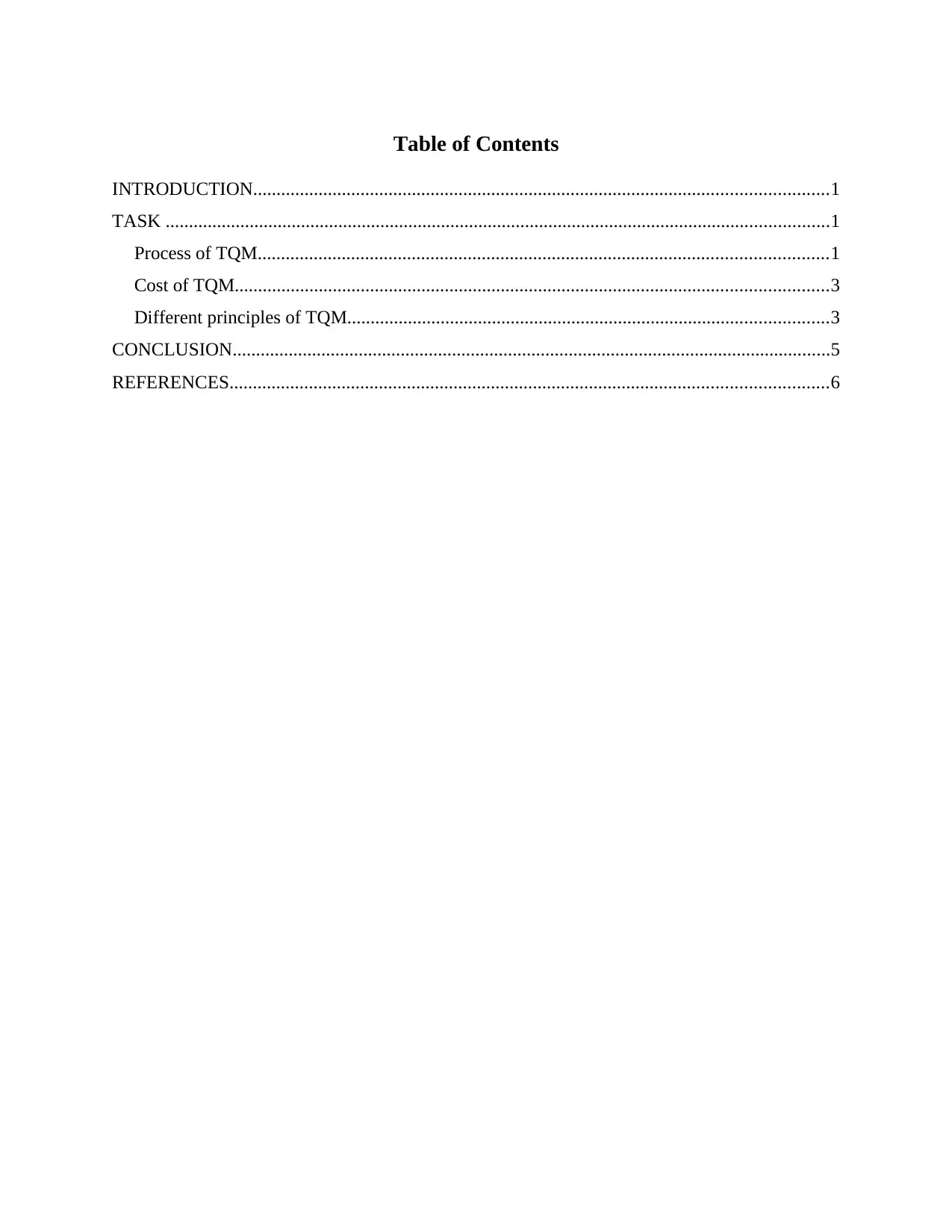
Table of Contents
INTRODUCTION...........................................................................................................................1
TASK ..............................................................................................................................................1
Process of TQM..........................................................................................................................1
Cost of TQM...............................................................................................................................3
Different principles of TQM.......................................................................................................3
CONCLUSION................................................................................................................................5
REFERENCES................................................................................................................................6
INTRODUCTION...........................................................................................................................1
TASK ..............................................................................................................................................1
Process of TQM..........................................................................................................................1
Cost of TQM...............................................................................................................................3
Different principles of TQM.......................................................................................................3
CONCLUSION................................................................................................................................5
REFERENCES................................................................................................................................6
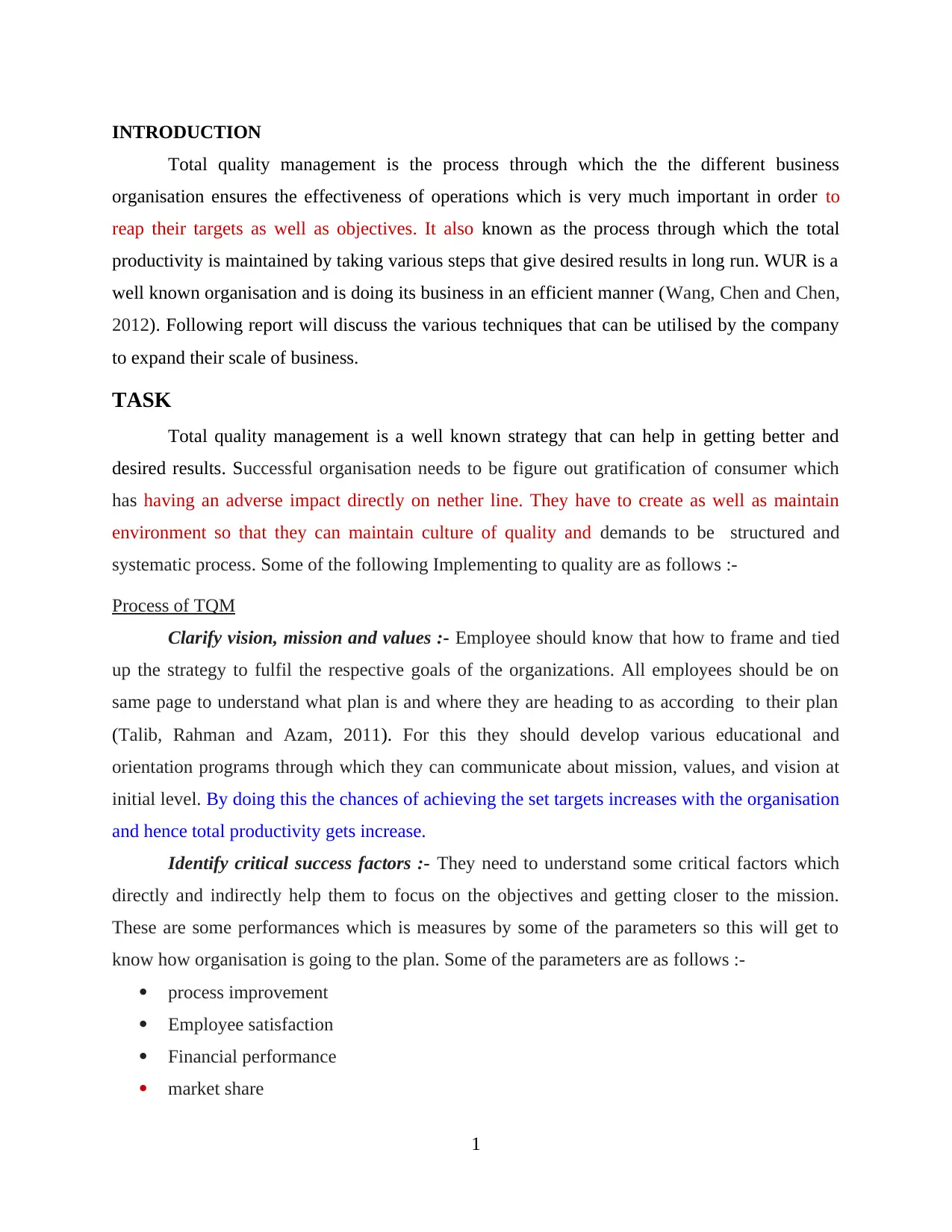
INTRODUCTION
Total quality management is the process through which the the different business
organisation ensures the effectiveness of operations which is very much important in order to
reap their targets as well as objectives. It also known as the process through which the total
productivity is maintained by taking various steps that give desired results in long run. WUR is a
well known organisation and is doing its business in an efficient manner (Wang, Chen and Chen,
2012). Following report will discuss the various techniques that can be utilised by the company
to expand their scale of business.
TASK
Total quality management is a well known strategy that can help in getting better and
desired results. Successful organisation needs to be figure out gratification of consumer which
has having an adverse impact directly on nether line. They have to create as well as maintain
environment so that they can maintain culture of quality and demands to be structured and
systematic process. Some of the following Implementing to quality are as follows :-
Process of TQM
Clarify vision, mission and values :- Employee should know that how to frame and tied
up the strategy to fulfil the respective goals of the organizations. All employees should be on
same page to understand what plan is and where they are heading to as according to their plan
(Talib, Rahman and Azam, 2011). For this they should develop various educational and
orientation programs through which they can communicate about mission, values, and vision at
initial level. By doing this the chances of achieving the set targets increases with the organisation
and hence total productivity gets increase.
Identify critical success factors :- They need to understand some critical factors which
directly and indirectly help them to focus on the objectives and getting closer to the mission.
These are some performances which is measures by some of the parameters so this will get to
know how organisation is going to the plan. Some of the parameters are as follows :-
process improvement
Employee satisfaction
Financial performance
market share
1
Total quality management is the process through which the the different business
organisation ensures the effectiveness of operations which is very much important in order to
reap their targets as well as objectives. It also known as the process through which the total
productivity is maintained by taking various steps that give desired results in long run. WUR is a
well known organisation and is doing its business in an efficient manner (Wang, Chen and Chen,
2012). Following report will discuss the various techniques that can be utilised by the company
to expand their scale of business.
TASK
Total quality management is a well known strategy that can help in getting better and
desired results. Successful organisation needs to be figure out gratification of consumer which
has having an adverse impact directly on nether line. They have to create as well as maintain
environment so that they can maintain culture of quality and demands to be structured and
systematic process. Some of the following Implementing to quality are as follows :-
Process of TQM
Clarify vision, mission and values :- Employee should know that how to frame and tied
up the strategy to fulfil the respective goals of the organizations. All employees should be on
same page to understand what plan is and where they are heading to as according to their plan
(Talib, Rahman and Azam, 2011). For this they should develop various educational and
orientation programs through which they can communicate about mission, values, and vision at
initial level. By doing this the chances of achieving the set targets increases with the organisation
and hence total productivity gets increase.
Identify critical success factors :- They need to understand some critical factors which
directly and indirectly help them to focus on the objectives and getting closer to the mission.
These are some performances which is measures by some of the parameters so this will get to
know how organisation is going to the plan. Some of the parameters are as follows :-
process improvement
Employee satisfaction
Financial performance
market share
1
⊘ This is a preview!⊘
Do you want full access?
Subscribe today to unlock all pages.

Trusted by 1+ million students worldwide
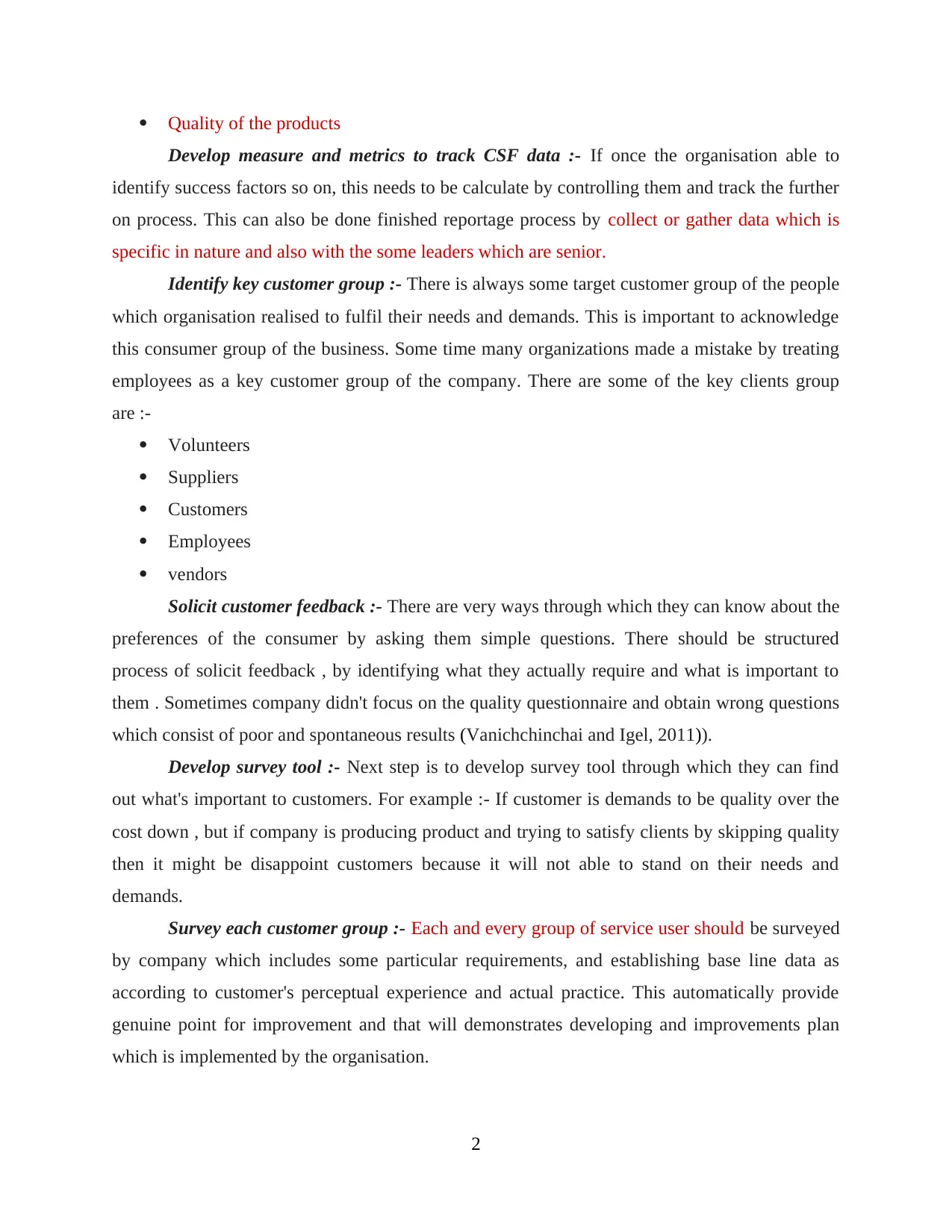
Quality of the products
Develop measure and metrics to track CSF data :- If once the organisation able to
identify success factors so on, this needs to be calculate by controlling them and track the further
on process. This can also be done finished reportage process by collect or gather data which is
specific in nature and also with the some leaders which are senior.
Identify key customer group :- There is always some target customer group of the people
which organisation realised to fulfil their needs and demands. This is important to acknowledge
this consumer group of the business. Some time many organizations made a mistake by treating
employees as a key customer group of the company. There are some of the key clients group
are :-
Volunteers
Suppliers
Customers
Employees
vendors
Solicit customer feedback :- There are very ways through which they can know about the
preferences of the consumer by asking them simple questions. There should be structured
process of solicit feedback , by identifying what they actually require and what is important to
them . Sometimes company didn't focus on the quality questionnaire and obtain wrong questions
which consist of poor and spontaneous results (Vanichchinchai and Igel, 2011)).
Develop survey tool :- Next step is to develop survey tool through which they can find
out what's important to customers. For example :- If customer is demands to be quality over the
cost down , but if company is producing product and trying to satisfy clients by skipping quality
then it might be disappoint customers because it will not able to stand on their needs and
demands.
Survey each customer group :- Each and every group of service user should be surveyed
by company which includes some particular requirements, and establishing base line data as
according to customer's perceptual experience and actual practice. This automatically provide
genuine point for improvement and that will demonstrates developing and improvements plan
which is implemented by the organisation.
2
Develop measure and metrics to track CSF data :- If once the organisation able to
identify success factors so on, this needs to be calculate by controlling them and track the further
on process. This can also be done finished reportage process by collect or gather data which is
specific in nature and also with the some leaders which are senior.
Identify key customer group :- There is always some target customer group of the people
which organisation realised to fulfil their needs and demands. This is important to acknowledge
this consumer group of the business. Some time many organizations made a mistake by treating
employees as a key customer group of the company. There are some of the key clients group
are :-
Volunteers
Suppliers
Customers
Employees
vendors
Solicit customer feedback :- There are very ways through which they can know about the
preferences of the consumer by asking them simple questions. There should be structured
process of solicit feedback , by identifying what they actually require and what is important to
them . Sometimes company didn't focus on the quality questionnaire and obtain wrong questions
which consist of poor and spontaneous results (Vanichchinchai and Igel, 2011)).
Develop survey tool :- Next step is to develop survey tool through which they can find
out what's important to customers. For example :- If customer is demands to be quality over the
cost down , but if company is producing product and trying to satisfy clients by skipping quality
then it might be disappoint customers because it will not able to stand on their needs and
demands.
Survey each customer group :- Each and every group of service user should be surveyed
by company which includes some particular requirements, and establishing base line data as
according to customer's perceptual experience and actual practice. This automatically provide
genuine point for improvement and that will demonstrates developing and improvements plan
which is implemented by the organisation.
2
Paraphrase This Document
Need a fresh take? Get an instant paraphrase of this document with our AI Paraphraser
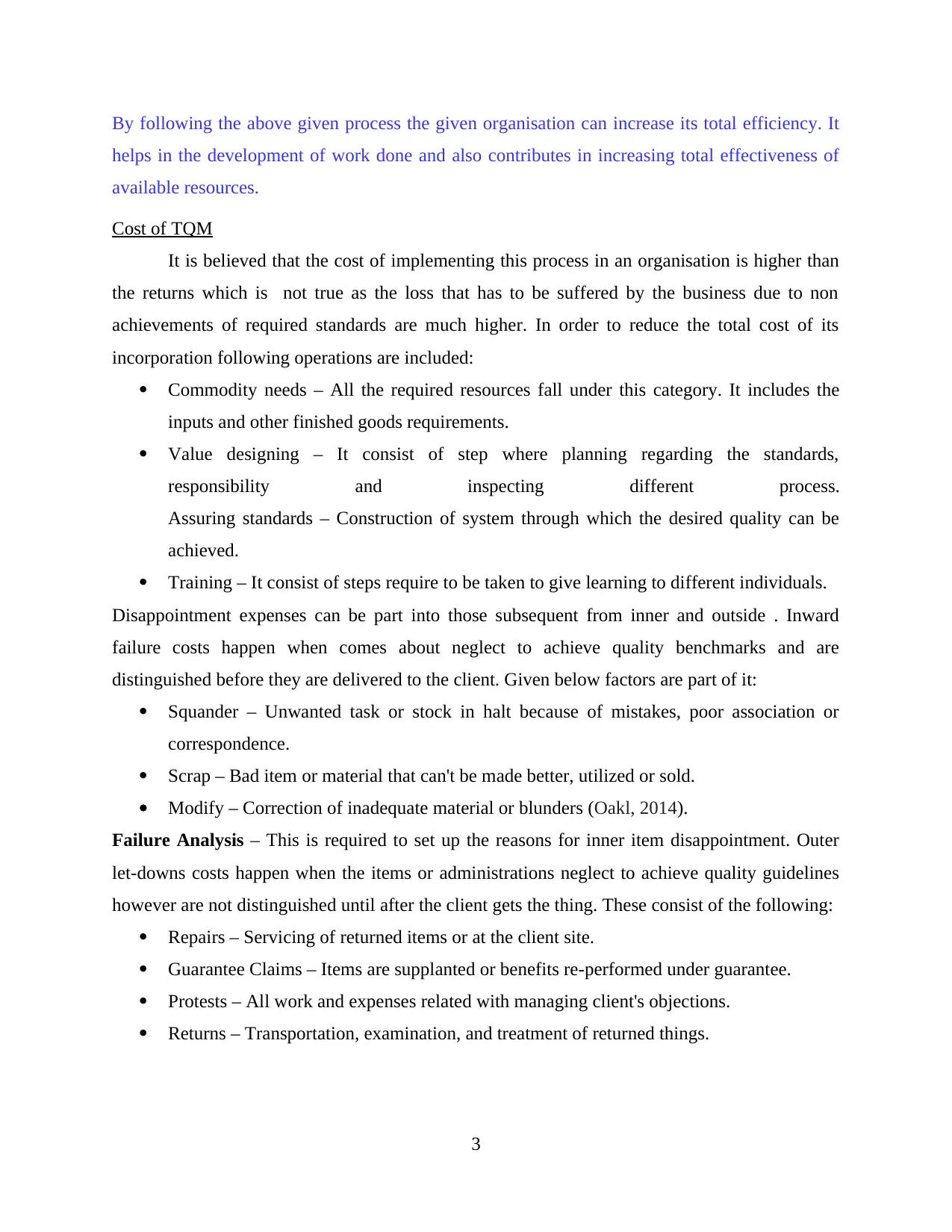
By following the above given process the given organisation can increase its total efficiency. It
helps in the development of work done and also contributes in increasing total effectiveness of
available resources.
Cost of TQM
It is believed that the cost of implementing this process in an organisation is higher than
the returns which is not true as the loss that has to be suffered by the business due to non
achievements of required standards are much higher. In order to reduce the total cost of its
incorporation following operations are included:
Commodity needs – All the required resources fall under this category. It includes the
inputs and other finished goods requirements.
Value designing – It consist of step where planning regarding the standards,
responsibility and inspecting different process.
Assuring standards – Construction of system through which the desired quality can be
achieved.
Training – It consist of steps require to be taken to give learning to different individuals.
Disappointment expenses can be part into those subsequent from inner and outside . Inward
failure costs happen when comes about neglect to achieve quality benchmarks and are
distinguished before they are delivered to the client. Given below factors are part of it:
Squander – Unwanted task or stock in halt because of mistakes, poor association or
correspondence.
Scrap – Bad item or material that can't be made better, utilized or sold.
Modify – Correction of inadequate material or blunders (Oakl, 2014).
Failure Analysis – This is required to set up the reasons for inner item disappointment. Outer
let-downs costs happen when the items or administrations neglect to achieve quality guidelines
however are not distinguished until after the client gets the thing. These consist of the following:
Repairs – Servicing of returned items or at the client site.
Guarantee Claims – Items are supplanted or benefits re-performed under guarantee.
Protests – All work and expenses related with managing client's objections.
Returns – Transportation, examination, and treatment of returned things.
3
helps in the development of work done and also contributes in increasing total effectiveness of
available resources.
Cost of TQM
It is believed that the cost of implementing this process in an organisation is higher than
the returns which is not true as the loss that has to be suffered by the business due to non
achievements of required standards are much higher. In order to reduce the total cost of its
incorporation following operations are included:
Commodity needs – All the required resources fall under this category. It includes the
inputs and other finished goods requirements.
Value designing – It consist of step where planning regarding the standards,
responsibility and inspecting different process.
Assuring standards – Construction of system through which the desired quality can be
achieved.
Training – It consist of steps require to be taken to give learning to different individuals.
Disappointment expenses can be part into those subsequent from inner and outside . Inward
failure costs happen when comes about neglect to achieve quality benchmarks and are
distinguished before they are delivered to the client. Given below factors are part of it:
Squander – Unwanted task or stock in halt because of mistakes, poor association or
correspondence.
Scrap – Bad item or material that can't be made better, utilized or sold.
Modify – Correction of inadequate material or blunders (Oakl, 2014).
Failure Analysis – This is required to set up the reasons for inner item disappointment. Outer
let-downs costs happen when the items or administrations neglect to achieve quality guidelines
however are not distinguished until after the client gets the thing. These consist of the following:
Repairs – Servicing of returned items or at the client site.
Guarantee Claims – Items are supplanted or benefits re-performed under guarantee.
Protests – All work and expenses related with managing client's objections.
Returns – Transportation, examination, and treatment of returned things.
3
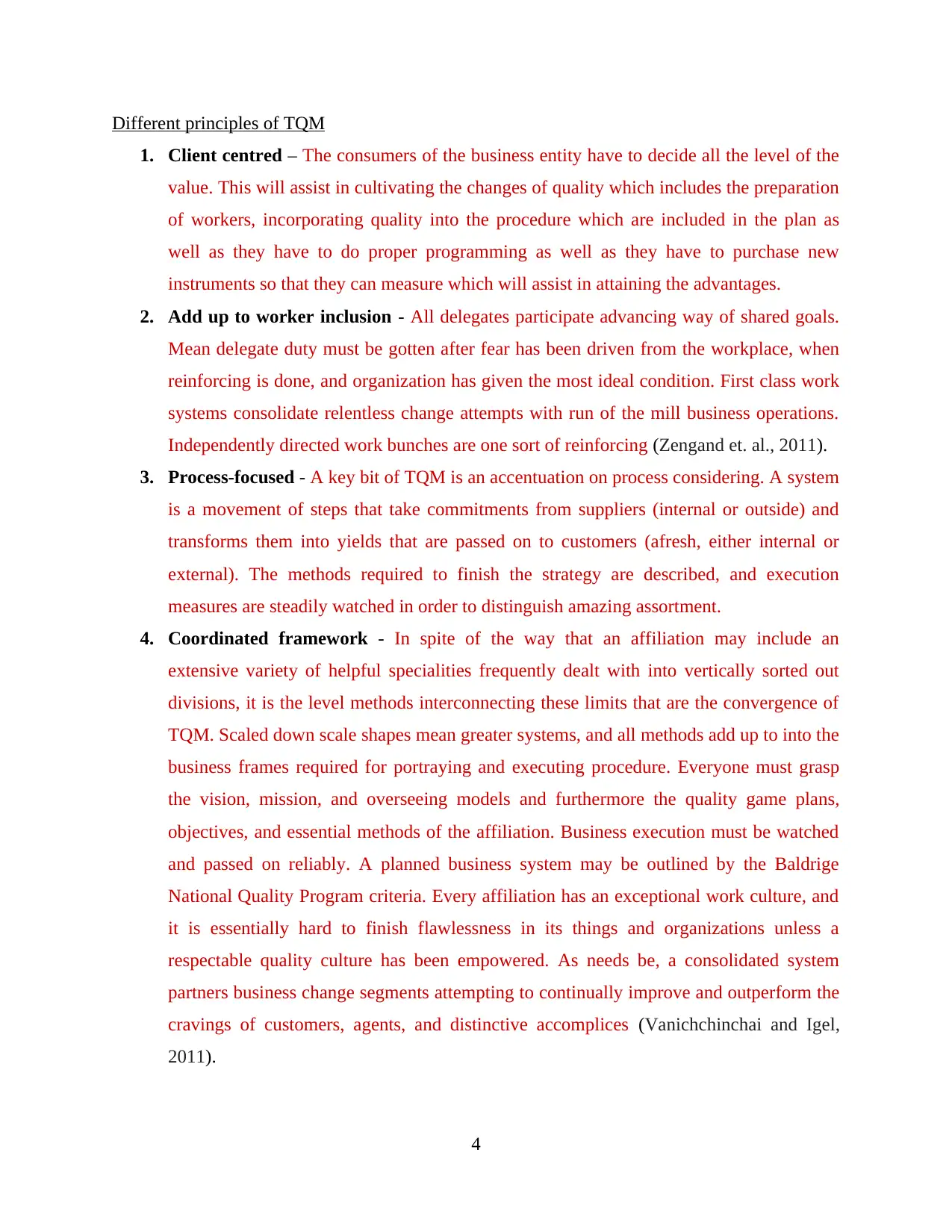
Different principles of TQM
1. Client centred – The consumers of the business entity have to decide all the level of the
value. This will assist in cultivating the changes of quality which includes the preparation
of workers, incorporating quality into the procedure which are included in the plan as
well as they have to do proper programming as well as they have to purchase new
instruments so that they can measure which will assist in attaining the advantages.
2. Add up to worker inclusion - All delegates participate advancing way of shared goals.
Mean delegate duty must be gotten after fear has been driven from the workplace, when
reinforcing is done, and organization has given the most ideal condition. First class work
systems consolidate relentless change attempts with run of the mill business operations.
Independently directed work bunches are one sort of reinforcing (Zengand et. al., 2011).
3. Process-focused - A key bit of TQM is an accentuation on process considering. A system
is a movement of steps that take commitments from suppliers (internal or outside) and
transforms them into yields that are passed on to customers (afresh, either internal or
external). The methods required to finish the strategy are described, and execution
measures are steadily watched in order to distinguish amazing assortment.
4. Coordinated framework - In spite of the way that an affiliation may include an
extensive variety of helpful specialities frequently dealt with into vertically sorted out
divisions, it is the level methods interconnecting these limits that are the convergence of
TQM. Scaled down scale shapes mean greater systems, and all methods add up to into the
business frames required for portraying and executing procedure. Everyone must grasp
the vision, mission, and overseeing models and furthermore the quality game plans,
objectives, and essential methods of the affiliation. Business execution must be watched
and passed on reliably. A planned business system may be outlined by the Baldrige
National Quality Program criteria. Every affiliation has an exceptional work culture, and
it is essentially hard to finish flawlessness in its things and organizations unless a
respectable quality culture has been empowered. As needs be, a consolidated system
partners business change segments attempting to continually improve and outperform the
cravings of customers, agents, and distinctive accomplices (Vanichchinchai and Igel,
2011).
4
1. Client centred – The consumers of the business entity have to decide all the level of the
value. This will assist in cultivating the changes of quality which includes the preparation
of workers, incorporating quality into the procedure which are included in the plan as
well as they have to do proper programming as well as they have to purchase new
instruments so that they can measure which will assist in attaining the advantages.
2. Add up to worker inclusion - All delegates participate advancing way of shared goals.
Mean delegate duty must be gotten after fear has been driven from the workplace, when
reinforcing is done, and organization has given the most ideal condition. First class work
systems consolidate relentless change attempts with run of the mill business operations.
Independently directed work bunches are one sort of reinforcing (Zengand et. al., 2011).
3. Process-focused - A key bit of TQM is an accentuation on process considering. A system
is a movement of steps that take commitments from suppliers (internal or outside) and
transforms them into yields that are passed on to customers (afresh, either internal or
external). The methods required to finish the strategy are described, and execution
measures are steadily watched in order to distinguish amazing assortment.
4. Coordinated framework - In spite of the way that an affiliation may include an
extensive variety of helpful specialities frequently dealt with into vertically sorted out
divisions, it is the level methods interconnecting these limits that are the convergence of
TQM. Scaled down scale shapes mean greater systems, and all methods add up to into the
business frames required for portraying and executing procedure. Everyone must grasp
the vision, mission, and overseeing models and furthermore the quality game plans,
objectives, and essential methods of the affiliation. Business execution must be watched
and passed on reliably. A planned business system may be outlined by the Baldrige
National Quality Program criteria. Every affiliation has an exceptional work culture, and
it is essentially hard to finish flawlessness in its things and organizations unless a
respectable quality culture has been empowered. As needs be, a consolidated system
partners business change segments attempting to continually improve and outperform the
cravings of customers, agents, and distinctive accomplices (Vanichchinchai and Igel,
2011).
4
⊘ This is a preview!⊘
Do you want full access?
Subscribe today to unlock all pages.

Trusted by 1+ million students worldwide
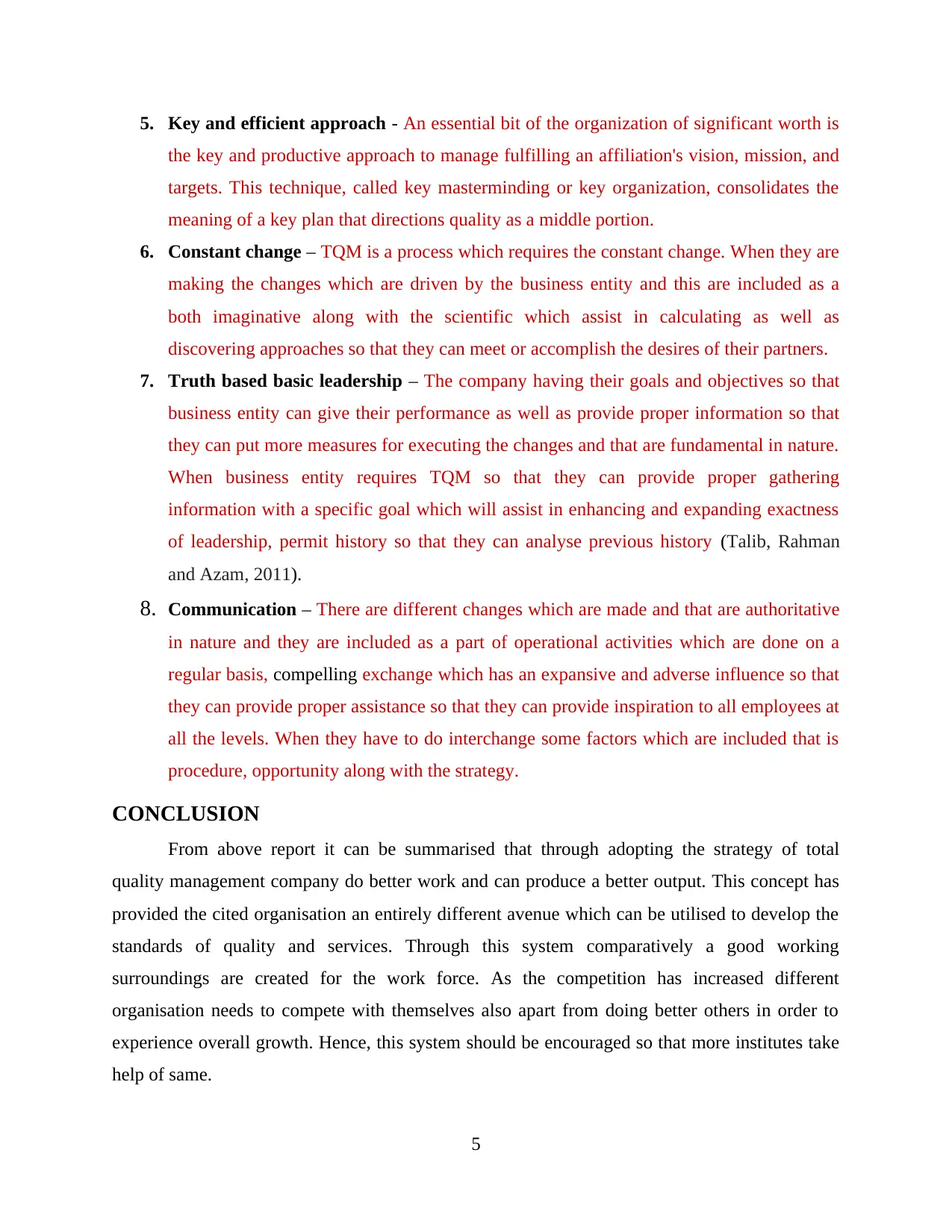
5. Key and efficient approach - An essential bit of the organization of significant worth is
the key and productive approach to manage fulfilling an affiliation's vision, mission, and
targets. This technique, called key masterminding or key organization, consolidates the
meaning of a key plan that directions quality as a middle portion.
6. Constant change – TQM is a process which requires the constant change. When they are
making the changes which are driven by the business entity and this are included as a
both imaginative along with the scientific which assist in calculating as well as
discovering approaches so that they can meet or accomplish the desires of their partners.
7. Truth based basic leadership – The company having their goals and objectives so that
business entity can give their performance as well as provide proper information so that
they can put more measures for executing the changes and that are fundamental in nature.
When business entity requires TQM so that they can provide proper gathering
information with a specific goal which will assist in enhancing and expanding exactness
of leadership, permit history so that they can analyse previous history (Talib, Rahman
and Azam, 2011).
8. Communication – There are different changes which are made and that are authoritative
in nature and they are included as a part of operational activities which are done on a
regular basis, compelling exchange which has an expansive and adverse influence so that
they can provide proper assistance so that they can provide inspiration to all employees at
all the levels. When they have to do interchange some factors which are included that is
procedure, opportunity along with the strategy.
CONCLUSION
From above report it can be summarised that through adopting the strategy of total
quality management company do better work and can produce a better output. This concept has
provided the cited organisation an entirely different avenue which can be utilised to develop the
standards of quality and services. Through this system comparatively a good working
surroundings are created for the work force. As the competition has increased different
organisation needs to compete with themselves also apart from doing better others in order to
experience overall growth. Hence, this system should be encouraged so that more institutes take
help of same.
5
the key and productive approach to manage fulfilling an affiliation's vision, mission, and
targets. This technique, called key masterminding or key organization, consolidates the
meaning of a key plan that directions quality as a middle portion.
6. Constant change – TQM is a process which requires the constant change. When they are
making the changes which are driven by the business entity and this are included as a
both imaginative along with the scientific which assist in calculating as well as
discovering approaches so that they can meet or accomplish the desires of their partners.
7. Truth based basic leadership – The company having their goals and objectives so that
business entity can give their performance as well as provide proper information so that
they can put more measures for executing the changes and that are fundamental in nature.
When business entity requires TQM so that they can provide proper gathering
information with a specific goal which will assist in enhancing and expanding exactness
of leadership, permit history so that they can analyse previous history (Talib, Rahman
and Azam, 2011).
8. Communication – There are different changes which are made and that are authoritative
in nature and they are included as a part of operational activities which are done on a
regular basis, compelling exchange which has an expansive and adverse influence so that
they can provide proper assistance so that they can provide inspiration to all employees at
all the levels. When they have to do interchange some factors which are included that is
procedure, opportunity along with the strategy.
CONCLUSION
From above report it can be summarised that through adopting the strategy of total
quality management company do better work and can produce a better output. This concept has
provided the cited organisation an entirely different avenue which can be utilised to develop the
standards of quality and services. Through this system comparatively a good working
surroundings are created for the work force. As the competition has increased different
organisation needs to compete with themselves also apart from doing better others in order to
experience overall growth. Hence, this system should be encouraged so that more institutes take
help of same.
5
Paraphrase This Document
Need a fresh take? Get an instant paraphrase of this document with our AI Paraphraser
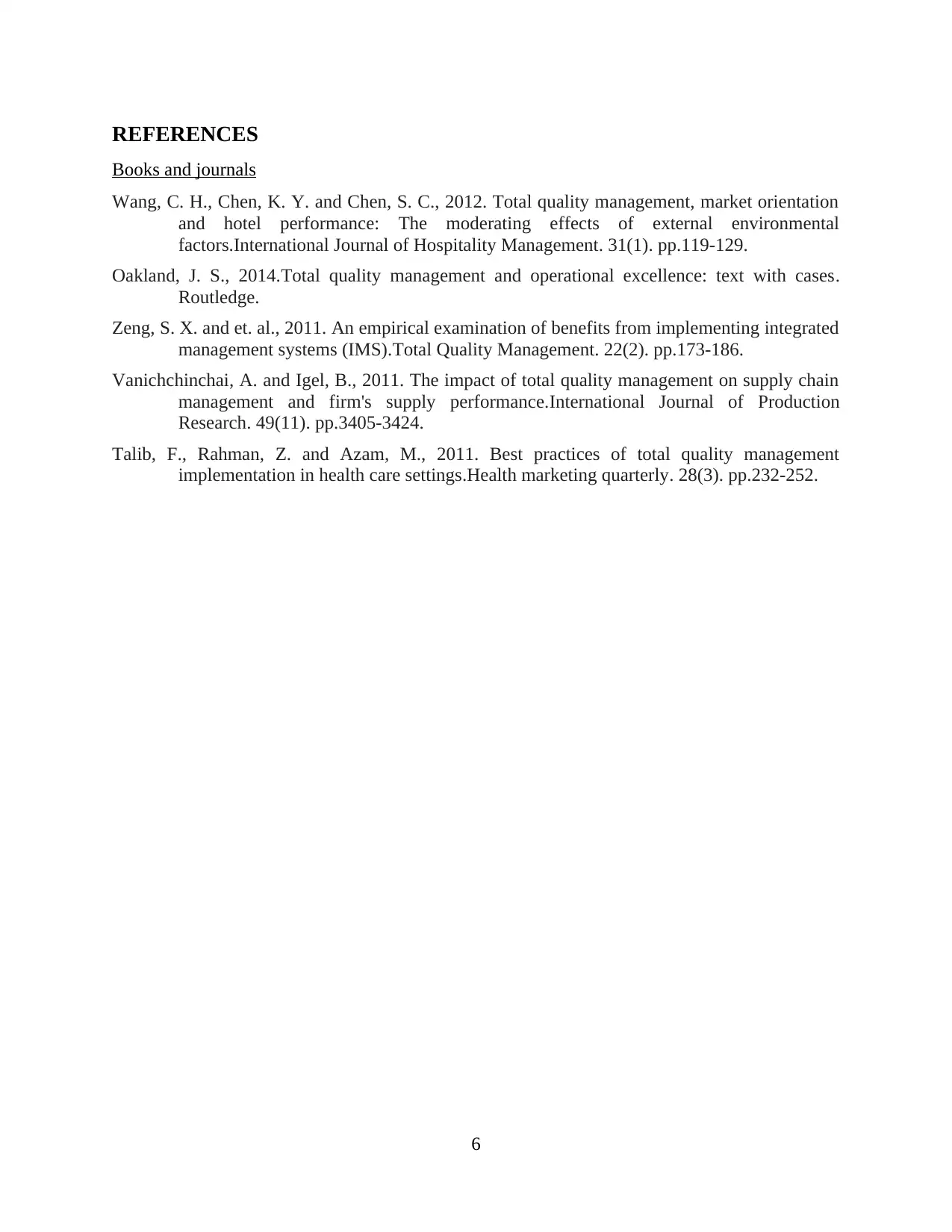
REFERENCES
Books and journals
Wang, C. H., Chen, K. Y. and Chen, S. C., 2012. Total quality management, market orientation
and hotel performance: The moderating effects of external environmental
factors.International Journal of Hospitality Management. 31(1). pp.119-129.
Oakland, J. S., 2014.Total quality management and operational excellence: text with cases.
Routledge.
Zeng, S. X. and et. al., 2011. An empirical examination of benefits from implementing integrated
management systems (IMS).Total Quality Management. 22(2). pp.173-186.
Vanichchinchai, A. and Igel, B., 2011. The impact of total quality management on supply chain
management and firm's supply performance.International Journal of Production
Research. 49(11). pp.3405-3424.
Talib, F., Rahman, Z. and Azam, M., 2011. Best practices of total quality management
implementation in health care settings.Health marketing quarterly. 28(3). pp.232-252.
6
Books and journals
Wang, C. H., Chen, K. Y. and Chen, S. C., 2012. Total quality management, market orientation
and hotel performance: The moderating effects of external environmental
factors.International Journal of Hospitality Management. 31(1). pp.119-129.
Oakland, J. S., 2014.Total quality management and operational excellence: text with cases.
Routledge.
Zeng, S. X. and et. al., 2011. An empirical examination of benefits from implementing integrated
management systems (IMS).Total Quality Management. 22(2). pp.173-186.
Vanichchinchai, A. and Igel, B., 2011. The impact of total quality management on supply chain
management and firm's supply performance.International Journal of Production
Research. 49(11). pp.3405-3424.
Talib, F., Rahman, Z. and Azam, M., 2011. Best practices of total quality management
implementation in health care settings.Health marketing quarterly. 28(3). pp.232-252.
6
1 out of 8
Related Documents
Your All-in-One AI-Powered Toolkit for Academic Success.
+13062052269
info@desklib.com
Available 24*7 on WhatsApp / Email
![[object Object]](/_next/static/media/star-bottom.7253800d.svg)
Unlock your academic potential
Copyright © 2020–2025 A2Z Services. All Rights Reserved. Developed and managed by ZUCOL.





